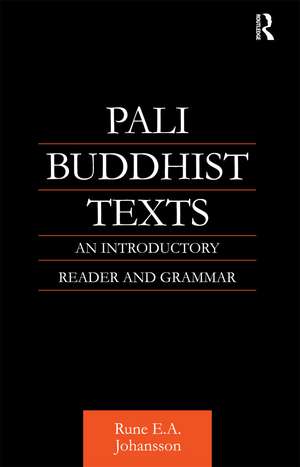Pali Buddhist Texts: An Introductory Reader and Grammar
Autor Rune E. A. Johanssonen Limba Engleză Paperback – 2 iun 1998
| Toate formatele și edițiile | Preț | Express |
|---|---|---|
| Paperback (1) | 461.12 lei 6-8 săpt. | |
| Taylor & Francis – 2 iun 1998 | 461.12 lei 6-8 săpt. | |
| Hardback (1) | 1000.27 lei 6-8 săpt. | |
| Taylor & Francis – 31 mar 2016 | 1000.27 lei 6-8 săpt. |
Preț: 461.12 lei
Nou
Puncte Express: 692
Preț estimativ în valută:
88.25€ • 91.79$ • 72.85£
88.25€ • 91.79$ • 72.85£
Carte tipărită la comandă
Livrare economică 14-28 aprilie
Preluare comenzi: 021 569.72.76
Specificații
ISBN-13: 9780700710683
ISBN-10: 070071068X
Pagini: 160
Dimensiuni: 156 x 234 x 12 mm
Greutate: 0.26 kg
Ediția:Revised edition
Editura: Taylor & Francis
Colecția Routledge
Locul publicării:Oxford, United Kingdom
ISBN-10: 070071068X
Pagini: 160
Dimensiuni: 156 x 234 x 12 mm
Greutate: 0.26 kg
Ediția:Revised edition
Editura: Taylor & Francis
Colecția Routledge
Locul publicării:Oxford, United Kingdom
Cuprins
Chapter 1 Experience is the only Criterion (Majjhima Nikaya I 265); Chapter 2 Definition of Suffering (Digha Nikaya II 305); Chapter 3 The Cause of Suffering (Digha Nikaya II 308); Chapter 4 The Cessation of Suffering (Digha Nikaya II 310); Chapter 5 The way to Freedom from Suffering (Digha Nikaya II 311); Chapter 6 The Impermanence of Life (Samyutta Nikaya I 109); Chapter 7 There is no Soul (Buddhaghosa, Visuddhimagga XVI 90); Chapter 8 Definition of Personality (Samyutta Nikaya 1135); Chapter 9 The Factors of Personality (Majjhima Nikaya I 435); Chapter 10 Feeling (Majjhima Nikaya I 302 f); Chapter 11 Perception and Ideation; Chapter 12 Three Types of Activity (Majjhima Nikaya I 301); Chapter 13 Volition and the Activities (Samyutta Nikaya III 60); Chapter 14 The Origin of Conscious Processes (Majjhima Nikaya I 259); Chapter 15 Conciousness and Rebirth (Anguttara Nikaya I 223; Chapter 16 Consciousness may be Calmed (Sutta Nipata, verses 734, 735); Chapter 17 The Psychological Law of Causality and Its Use; Chapter 18 Liberation is a Natural Process (Anguttara Nikaya V 2 f); Chapter 19 The Origin and Control of Suffering (Samyutta Nikaya IV 86); Chapter 20 Everything is Caused (Samyutta Nikaya I 134); Chapter 21 Man Forms his Own Destiny (Dhammapada, verse 80); Chapter 22 Karma Sometimes Works Slowly (Dhammapada, verse 71); Chapter 23 How Rebirth is Influenced by Actions (Anguttara Nikaya I 122); Chapter 24 A Strong Wish May Influence Rebirth (Majjhima Nikaya III 99 f); Chapter 25 A Summary of the Way (Dhammapada, verse 183); Chapter 26 Monk or Not? (Majjhima Nikaya III 33); Chapter 27 The First Part of the Way: Right View (Digha Nikaya II 311 f); Chapter 28 Right Purpose (Digha Nikaya II 312); Chapter 29 Right Speech (Digha Nikaya II 312); Chapter 30 A More Detailed Definition of Right Speech (Anguttara Nikaya V 205); Chapter 31 Right Action (Digha Nikaya II 312); Chapter 32 How the Perfect Ones Live (Anguttara Nikaya I 211 f); Chapter 33 Right Livelihood (Digha Nikaya II 312); Chapter 34 Wrong Livelihood (Majjhima Nikaya III 75); Chapter 35 Right Effort (Digha Nikaya II 312); Chapter 36 Right Mindfulness (Digha Nikaya II 292); Chapter 37 Irradiation of Friendliness, Compassion, Tenderness, and Equanimity (Digha Nikaya III 223 f); Chapter 38 The First of the Nine Levels of Concentration (Digha Nikaya I 182); Chapter 39 The Second Level Of Concentration (Digha Nikaya I 182); Chapter 40 The Third Level of Concentration (Digha Nikaya I 183); Chapter 41 The Fourth Level of Concentration (Digha Nikaya I 183); Chapter 42 The Fifth, Sixth and Seventh Levels of Concentration (Digha Nikaya I 183); Chapter 43 The Eighth and Ninth Levels of Concentration (Anguttara Nikaya IV 448); Chapter 44 The State of Emptiness (Majjhima Nikaya III 293 f); Chapter 45 How to Meet Persecution and Death (Majjhima Nikaya I 186); Chapter 46 A Nun Tells her Story (Therigatha, verses 78-81); Chapter 47 The Buddha Relates how he Attained Nirvana (Majjhima Nikaya I 167); Chapter 48 Nirvana (Theragatha, verse 79); Chapter 49 Happiness (Theragatha, verse 227); Chapter 50 Nirvana is within Reach (Therigatha, Verses 511–513); Chapter 51 The Unborn (Udana, p 80); Chapter 52 Nirvana and Death (Sutta Nipata, verses 1074, 1076);
Descriere
Pali is one of the Middle Indian idioms and the classical language of Theravada Buddhism - and thus important both to linguists and scholars of Buddhism. The original texts collected here are selected for their important and beautiful formulation of Buddhist ideas.




